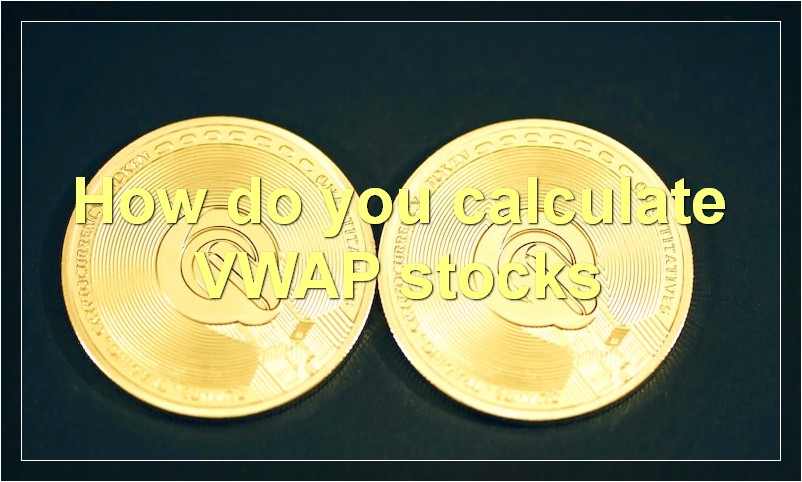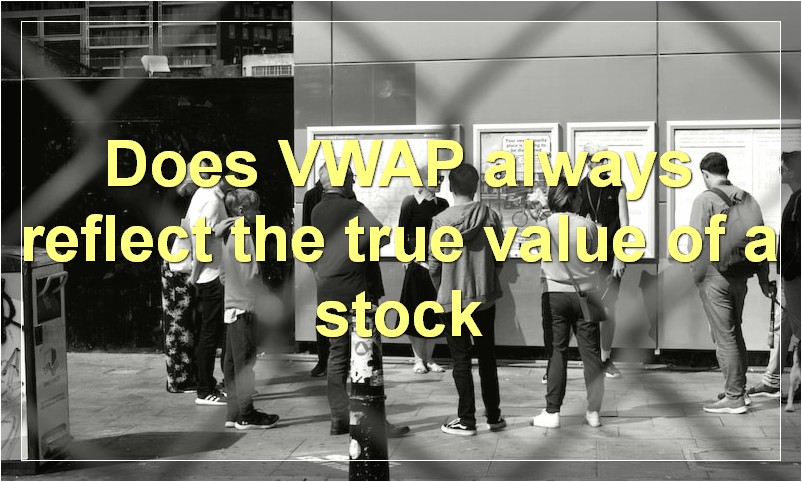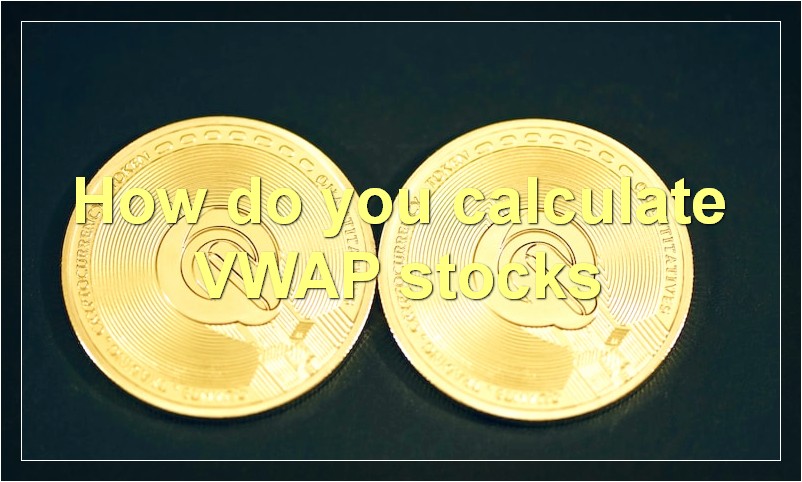The average investor may be unaware of the tool known as VWAP, or volume-weighted average price. However, for those in the know, VWAP can be a powerful tool to trade stocks. In this article, we will explore the benefits and risks of using VWAP to trade stocks.
What is the VWAP stocks formula
There are a lot of different formulas out there for valuing stocks, but the VWAP stocks formula is one of the most popular. The VWAP (Volume Weighted Average Price) is a measure of the average price of a stock over a given period of time, weighted by the volume of shares traded.
The VWAP formula is simple: you take the sum of all the prices paid for a stock during the day, multiplied by the number of shares traded at that price, and then divide it by the total number of shares traded. This gives you the average price paid for the stock, weighted by volume.
The VWAP is a popular metric because it takes into account both the price and the volume of shares traded, which can be helpful in assessing the true value of a stock. It’s also easy to calculate, which makes it a popular choice for traders.
There are a few things to keep in mind when using the VWAP formula. First, it’s important to use a large enough sample size to get an accurate measure. Second, the VWAP can be affected by outliers, so it’s important to be aware of that. Finally, the VWAP is just one tool in your toolbox – it’s not perfect, and shouldn’t be used as the sole basis for making trading decisions.
With that said, the VWAP is a valuable metric that can be helpful in your stock analysis. Give it a try and see how it can help you make better trading decisions!
How do you calculate VWAP stocks

If you’re looking to trade stocks, one important metric you may want to consider is the volume-weighted average price (VWAP). In general, the VWAP is a measure of the average price at which a stock is traded over the course of a given day.
To calculate VWAP, you first need to determine the total dollar value of all trades made in a stock during the day. To do this, you simply need to multiply the number of shares traded by the price of each trade. Once you have the total dollar value, you can then divide that figure by the total number of shares traded.
For example, let’s say that ABC Corporation has a stock price of $10 per share. During the course of a typical day, 500,000 shares of ABC Corporation are traded. The total dollar value of all trades made in ABC Corporation would be 500,000 x $10, or $5 million.
To calculate the VWAP, we would simply divide $5 million by 500,000 to get an average price of $10 per share.
While the VWAP is just one metric that traders use to make decisions, it can be a helpful tool in gauging the overall strength or weakness of a stock. If the VWAP is trending higher over time, it may be an indication that the stock is in demand and potentially undervalued. Conversely, if the VWAP is trending lower, it may be an indication that the stock is overvalued and not as attractive to traders.
What is the difference between VWAP and regular stocks
The difference between VWAP and regular stocks is that VWAP is the volume weighted average price of a security over a given period of time, while the regular stock price is simply the most recent trade price. VWAP is used by traders to assess whether they are getting a good price for their shares, and to help them make decisions about when to buy and sell.
Why do some traders use VWAP
Some traders use VWAP to help them make decisions about when to buy and sell stocks. VWAP is the volume-weighted average price of a stock. It’s calculated by adding up all of the prices of the stock trades that have happened during the day, and then dividing that number by the total number of shares that were traded.
Some traders believe that VWAP is a good indicator of where the stock is likely to trade for the rest of the day. They often use it as a reference point to help them decide whether to buy or sell.
What are the benefits of using VWAP
Using VWAP as a measure of central tendency can provide some benefits in trading. For one, because VWAP is based on actual volume traded throughout the day, it can offer a more accurate representation of where the market is truly trading at any given moment, rather than where it last traded. This is especially useful in fast-moving markets or when large trades are executed that could skew other measures such as last sale price.
Another potential benefit of using VWAP is that it can help traders avoid getting caught up in temporary price movements that are not representative of the underlying trend. This is because VWAP lags price by a small amount, so it smooths out some of the noise in prices. This can be helpful for traders who want to stay focused on the bigger picture.
Of course, like any other technical indicator, VWAP is not perfect and it should not be used in isolation. It is always important to consider other factors such as price action, momentum, and support and resistance levels before making any trading decisions.
Does VWAP always reflect the true value of a stock

When it comes to investing in stocks, there are a lot of different factors that you have to take into account. One of the most important things that you need to look at is the VWAP, or the volume weighted average price. This is a metric that is used to measure the average price of a stock over a certain period of time, and it can be very helpful in determining whether or not a stock is under or overvalued.
However, it’s important to keep in mind that VWAP is not always an accurate reflection of the true value of a stock. There are times when the VWAP can be skewed by factors such as large trades or unusual trading activity. So, while it’s a good metric to use as a starting point, you should always do your own research before making any investment decisions.
How can I use VWAP to my advantage
If you’re a day trader, then you know that volume-weighted average price (VWAP) is an important metric to watch. VWAP is a good indicator of the trading day’s momentum and can be used as a guide for setting prices. Here’s how you can use VWAP to your advantage.
First, let’s review what VWAP is and how it’s calculated.VWAP is the average price of a security over a specific period, weighted by volume. So, if a stock has traded at $10 for 1,000 shares and $20 for 2,000 shares, the VWAP would be $15. To calculate VWAP, you simply add up all the prices of all the trades that have happened in a day, and then divide by the total number of shares traded.
Now that we know how VWAP is calculated, let’s look at how it can be used to your advantage.
1. Use VWAP to time your entries and exits.
You can use VWAP as a guide for when to buy or sell a security. If the price is trading below VWAP, it may be a good time to buy, as you’re getting the security at a discount. Similarly, if the price is trading above VWAP, it may be a good time to sell, as you’re getting a premium price.
2. Use VWAP to identify trend changes.
VWAP can also be used to identify changes in the market trend. If the price is consistently trading above VWAP, it’s likely in an uptrend. Likewise, if the price is consistently trading below VWAP, it’s likely in a downtrend.
3. Use VWAP to set your own prices.
If you want to trade at a specific price, you can use VWAP as reference point. For example, if you want to buy a stock at $10 per share, you can place an order to buy when the stock trades at $9.50 – this is known as buying on the dip. Conversely, if you want to sell a stock at $20 per share, you can place an order to sell when the stock trades at $20.50 – this is known as selling on the uptick.
4. Use VWAP to assess risk/reward.
When buying or selling a security, it’s important to assess the risk/reward ratio. You can use VWAP to help with this calculation. For example, let’s say you’re looking at buying a stock at $10 per share with a stop loss at $9 per share. Your risk is $1 per share ($10-$9), and your potential reward is $1 per share ($11-$10). This gives you a risk/reward ratio of 1:1 – not ideal, but not terrible either. However, if you wait for the stock to trade down to $9.50 before buying, your risk decreases to $0.50 per share while your potential reward stays at $1 per share. This gives you a much better risk/reward ratio of 1:2 – now we’re talking!
5. Use VWAP to make better decisions about where to put your money.
Finally, you can use VWAP as part of your overall investment strategy. For example, let’s say you’re considering investing in two different stocks – Stock A and Stock B. Both stocks are currently trading at $10 per share. However, Stock A has been trading below its VWAP for the past week while Stock B has been trading above its VWAP for the past week. This indicates that Stock A is probably undervalued while Stock B is probably overvalued. As such, you may want to consider investing in Stock A over Stock B – after all, isn’t that what investing is all about?
In conclusion, there are many ways you can use
Is there a downside to using VWAP
There are a few potential downsides to using VWAP as a trading strategy. First, because VWAP is based on historical volume data, it may not be an accurate predictor of future volume. This could lead to trade execution problems, as there may not be enough liquidity to fill an order at the VWAP price. Second, VWAP can be lagging indicator, meaning it may not provide timely buy or sell signals. Finally, VWAP is just one indicator and should not be used in isolation; rather, it should be part of a broader trading strategy that includes other technical indicators and fundamental analysis.
What happens ifVWAP is breached
If VWAP is breached, it could mean that the stock price is going up or down. If the stock price is going up, it means that there is more buying than selling pressure and vice versa.
Can using VWAP help me avoid bad trades
Many traders use the volume weighted average price (VWAP) to help them gauge where a stock is likely to trade during the course of the day. By using VWAP, traders can avoid bad trades and make better-informed decisions about when to buy and sell.

